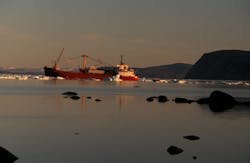WWF-Canada: Country should modernize grey water discharge rules
OTTAWA, DECEMBER 13, 2016, 2016 -- To protect the especially sensitive Arctic ecosystem, WWF-Canada is urging Transport Canada -- which is currently revising safety and pollution regulations -- to officially adopt the same or stronger levels of regulations on grey water discharged in waters north of 60 degrees latitude as apply south of 60.
Although untreated grey water has similar pollution impacts as sewage, ships passing through Arctic waters in Canada are not expected to adhere to any specific regulations for dumping this harmful waste. Transport Canada rules are much more stringent for waters below the 60th parallel.
Spurred by the first major cruise ship journey through the Northwest Passage this past summer, WWF-Canada undertook research into grey water regulations. The research revealed that in southern Canadian waters grey water is clearly defined and has specific discharge regulations. The same doesn't apply to the North, which means grey water can be freely discharged into the marine environment.
This lack of regulation is also vastly different from the standards in place in neighbouring Alaska, which include a specific definition of grey water and strict requirements designed to monitor and protect the Arctic ecosystem.
What is grey water
Grey water is the discharge from the sinks, showers and galleys on ships, but does not include drainage from toilets. It can contain a wide variety of polluting substances, such as faecal coliform bacteria (from human waste), food waste, oil and grease, detergent and soap residue, metals, solids and nutrients.
Environmental impacts
Nutrients in grey water can lead to dead zones caused by excessive algal growth.
Oil and grease coat the gills of fish and prevent them from being able to breathe.
Increased particulate matter in the water can potentially suffocate smaller species such as crabs, lobsters and sponges
Invasive species in grey water can be introduced into the ecosystem.
What Canada should do
Designate grey water as a specific type of waste in waters north of 60 degrees latitude, which cuts through Hudson Bay and is generally where the provinces and territories meet.
Improve standards to at least align with Alaska, which stipulates that grey water cannot be discharged unless it meets strict requirements concerning levels of suspended solids and fecal coliform. This means requiring stringent sampling, testing, record keeping and reporting.
Institute an effective inspection and enforcement system to ensure requirements are met.
Why address this now
Levels of shipping are expected to increase in the Arctic, including large cruise ships that can hold more than 1,600 passengers and crew
This is a prime opportunity to harmonize with Alaskan regulations to address traffic moving through this transboundary ecosystem, as Transport Canada is currently revising safety and pollution regulations before the Polar Code (created by the International Maritime Organization to protect the waters around the poles) comes into force in the new year.
"The Arctic is one of Canada's most sensitive ecosystems, and it's unacceptable that it's the least protected. In its current examination of Arctic shipping regulations, Transport Canada has an opportunity to correct this oversight on grey water, thereby adding a level of protection for an ecosystem already undergoing massive shifts due to climate-change," Paul Crowley, WWF-Canada vice-president of Arctic conservation, says.
About World Wildlife Fund Canada
WWF-Canada creates solutions to the environmental challenges that matter most for Canadians. We work in places that are unique and ecologically important, so that nature, wildlife and people thrive together. Because we are all wildlife. For more info visit wwf.ca
